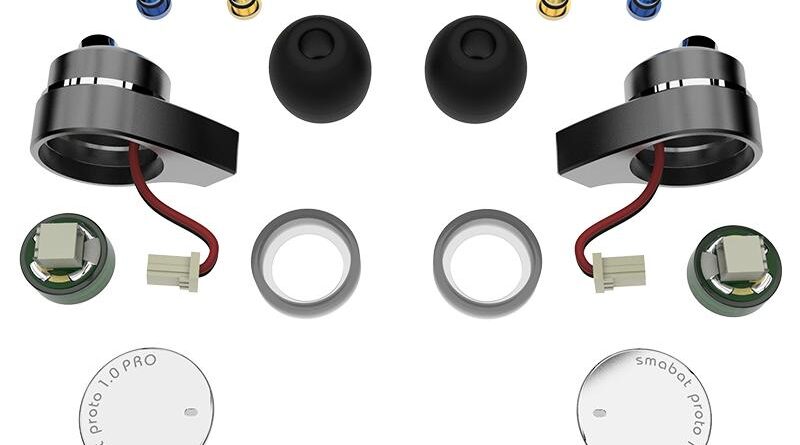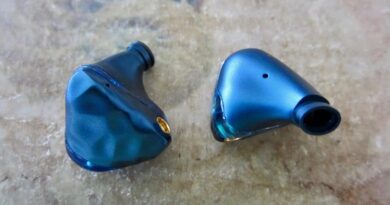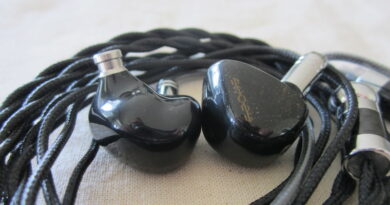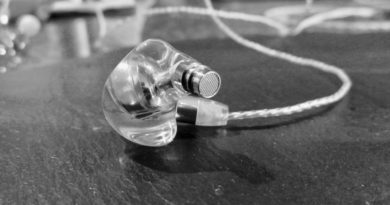Smabat Proto 1.0 – Work In Progress?
As a kid I certainly was fond of Lego blocks. Now as an old grumpy bear I’m much less into spending time building my own stuff, I prefer to pay for a professionally refined, ready to enjoy product or service. Yet, quite some time has passed from the former phase to the current one (more than 50 years, indeed). Why shouldn’t I give a chance to modern modular tech?
With this spirit I’m assessing a pair of Smabat Proto 1.0 modular IEMs which I got from the manufacturer for this purpose. Their street price is currently $79,00 – so not one of those excessively cheap chifi thingies – and you can find them on their website, besides multiple distributors on AE as always.
In this Article
At-a-glance Card
| PROs | CONs |
| Brilliant fully-modular concept, in a more than decent implementation | Stock Titanium driver: sub-bass totally rolled off, sounds like an earbud |
| Appealing, fun product for the modding lovers | Stock Titanium driver: awfully sloppy midbass |
| Stock Titanium driver: very good stage projection | Stock dampeners impact too dramatically on presentation. Softer-impact dampeners reportedly “in the works” but not available yet. |
| Stock Titanium driver: above average imaging | Spare driver modules market availability “dalayed”. |
| Nice cable | Horrible stock eartips + lip-less, small diameter nozzle design |
| Sound quality off stock elements not up to package price |
Modularity for everyone
Extensive modularity on a finished product like IEMs is commercially a very interesting idea, clinging to all those who feel enticed by DYI but (right or wrong) look at themselves as impaired or more simply too lazy to take that route. With them in mind, Smabat Proto 1.0 is the closest thing to a Lego project box.
With Proto 1.0 you can:
Swap the main dynamic driver transducer.
You can take the transducer coming with the main package, and replace with a different version, sold separately, supposed to deliver a different sound presentation.
The housings can easily be opened and closed by bare hands, revealing that the driver’s cabling features a small plug/unplug fixing.
Sadly I only got the basic package, in particular I got none of the alternative drivers to check.
Add a filter onto the main sound output nozzle, to tune trebles behaviour.
The default being “no filter”, inside the box a blue little item is available which is supposed to be optionally plugged onto the nozzle to smash highmids and treble frequencies flat down by a whopping -7dB (!!). Not a small nudge at all, rather a dramatic intervention on the entire upper part of the presentation.
Roll another filter, installed directly on the housing, to tune bass behaviour.
By default a gold-colored little cap is installed, which is part of the house-tuning so to say.
Inside the box 2 alternative cap pairs are provided, carriying different mesh filters, and distinct by their colours: silver ones are supposed to smash mid and low frequencies (from 1KHz down) down by -6dB, while red ones are supposed to kick them way up by the same, opposite sign amount: +6dB. Again: a major intervention, not at all a fine tuning thingie.
Comments
Before getting to the sound analysis, I feel a few comments are in order here about Proto 1.0’s modular design.
Housing dampeners are very difficult to take out, the more so with the bundled tweezers, which I suspect are more aimed at facilitating plugging/unpligging the main driver’s connector. My wife’s “professional” eyebrow tweezers helped better with those colored dampeners. I suggested Smabat to finetune their design.
Proto 1.0 come equipped with a 10mm Titanium Diaphragm, 16 ohm impedance driver. According to Smabat, such driver is supposed to offer a warm, mid-centric presentation, good but not overly powerful bass, and rich and clear high frequencies. As you will read further down, this is not entirely true – but that’s not the point here.
As previously mentioned, both treble (nozzle) and bass (housing) dampening filters apply a nothing short of brutal variation to the “default” tuning. It’s quite evident that a lower-impact version of such filters would be very interesting to test. Questioned about this, the manufacturer commented “Regarding the silver damper, we will add some bass in subsequent adjustments”.
When I got this sample unit a few weeks ago on their Ali Express shop Smabat advertised 3 alternative drivers: a Beryllium Plated Diaphragm (32 ohm) supposed to offer a “levelled presentation accross the entire frequency spectrum”, a Fiber Membrane (16 ohm) driver supposed to offer a more V shaped alternative, and a Dome LCP (22 ohm) supposed to offer a bright-enhanced alternative.
I obviously asked for those to be sent to me for a direct comparison, particularly the Beryllium Plated one (why that? simply because the default Titanium one is too warm, missing sub-bass and dominated by awfully bloating midbass – so I’d like to check how one which tuning is defined “levelled” in Smabat’s language would sound).
Sadly, the manufacturer’s answer was: “Other drives will be delayed, we are still testing to confirm. You can publish your assessment first.”
It’s worth noting that after a couple of weeks I checked again on Smabat website and there was no mention for a Beryllium Plated Diaphragm spare driver anymore, whilst a Titanium Plated Diaphragm (20 ohm) spawned in its place. Who knows if at least the range is to be considered final now, and when will those, or at least a few of them, be actually ready for shipping ?
Lastly, in addition to the two “user side” main vent openings (the main nozzle, and the other hole near the nozzle supposed to be equipped with bass-tuning dampeners), there is a third small vent opening on the housings’ back plates. Being a backside vent that is of course impacting on bass behaviour. Looking on the inside part of the removable backplate I can see a small white filter is installed. Oddly enough, Smabat does not offer spare / alternative filters to be rolled on that position. Why ?
All’n’all, everything seems to suggest that “Proto 1.0” is a quite meant naming for this product: it’s a prototype, and the first version thereof too!
Enough intro, let’s listen.
Full Device Card
Test setup
Sources: Apogee Groove / Apogee Groove + Burson FUN + IEMatch / Questyle QP1R / Cowon Plenue 2 – final E clear tips – Stock cable – lossless 16-24/44.1-192 FLAC tracks.
Signature analysis
| Tonality | Proto 1.0’s presentation and tonality vary depending on the hardware configuration of course. On the default Titanium Diaphragm driver we go from very laidback and soft to more aggressive, with a definite midrange prevalence and a distinct warm tonality being common to all variations. |
| Sub-Bass | Sub bass is totally rolled off. Proto 1.0 sound like an earbud, and not one of those paying too much attention to bass extention either. |
| Mid Bass | Midbass is slow, awfully sloppy or totally unhearable – depending on the bass filter choice. I had to use the silver nozzle dampener (the one supposed to attenuate bass most of all) to make it at least “just slow”, but as such it still remained quite invasive onto the mids, and definitely not organic. Paired directly to Groove, Proto 1.0 benefits of the Apogee device’s spectacular bass control and midbass + silver dampener gets into “somewhat decent” territory, but that’s as much ahead I could get. Considering the silver dampener is the sole one that makes midbass somewhat beareable to me, I conducted all audition with that mounted on – so keep this in mind when reading the rest of my notes here below. |
| Mids | Mids are not bad at all – clearly the best part of the presentation. Unrecessed although not particularly forward, and well textured. Especially guitars and female vocals are very pleasing. Male vocals are also good on solo situations, but their life is made very difficult by the unruly midbass most of the times. |
| Highs | High mids and trebles are just ok-ish on stock situation (i.e.: without a filter mounted onto the nozzle). Vivid and somewhat airy on one end, they would be much better if they weren’t perceivably grainy, and quite frequently splashy, too. Splashyness and most of the grainness do go away by installing the blue nozzle dampener (you remember? the one supposed to slam highmids and trebles down by 7dB!), but when you do it you (of course!!) also lose air and most if not all of the vividness: highmids and trebles are so much “laid back down” by the blue dampener as to make the presentation definitely dull – for my tastes at least. |
Technicalities
| Soundstage | Stage projection is really good on Proto 1.0. Height, in particular, is superb. Depth is very good, width above average. |
| Imaging | Imaging is ok, even above average for IEMs in this price class. |
| Details | Microdetail retrieval is no more than average when factoring Proto 1.0’s asking price. |
| Instrument separation | Instrument separation on Proto 1.0 stock condition is jammed by the midbass and limited by trebles’ splashinessy. Applying filters the situation improves, but at the cost of serious dullness. |
| Driveability | Power wise the stock Titanium Diaphragm driver is very easy to bias. Its midbass unruly nature does greatly benefit from higher-tier sources featuring particular bass control. |
Physicals
| Build | Housings are made of metal, and designed around a classical A-B dual-deflation chamber tech. In practical terms this means that air vibrations can vent both from the user side (A), where the main output nozzle and a further opening exist on the main housing, and from the backplate side (B) where a small vent hole is present. Housings can be open by popping the backplate off, revealing a removable, easy user-replaceable transducer unit. While the backplate popping process requires a small flathead screwdriver (or iron fingernails) to act as a lever, repositioning and sealing it back is quite easy and feels convincingly safe. On the housings’ front side, next to the nozzle, there’s a round hole on which a meshed cylindrical “plug” is supposed to be installed at all times. Its purpose is modulating bass frequencies depending on the specific mesh/filter being plugged in there. Such cylindrical plugs can and should be fully pushed-in when installed, which makes it quite difficult to pull them out. A small pair of tweezers is supplied with the package, but those are unfit for the task. The main nozzle may also (this time optionally) be equipped with a meshed “plug-in” element. In this case the purpose is impacting on high mids and treble frequencies tuning. Installing and removing such plug-in element on the nozzle is quite easy. |
| Fit | Main nozzles have a quite small diameter, and a too regular external surface: no “lip” ring is present to facilitate eartips grip on them, and in facts pretty much all eartips I tried on Proto 1.0, including first of all the stock ones (!), have an infuriating tendency to slip off while you pull the drivers off your ears. In addition to the above, stock silicon eartips are nothing short of horrible quality: too soft, flimsy even – and, as just mentioned, their stem is simply too wide to firmly adapt onto the housings nozzles. The vast majority of the tips in my collections also couldnt properly fit onto Proto 1.0’s nozzle for the very same reasons. In the end a “decent” compromise is represented by final E series, the clear version which do contribute a further bit to tame Proto 1.0’s unruly midbass transients. |
| Comfort | Once fitted, Proto 1.0 feel quite comfy to my ears. Their shape is such that cable-up is the sole realistically viable installation position, there’s this to note too. |
| Isolation | Due to their shape, and the vents, Proto 1.0 offer a not more than average isolation |
| Cable | Proto 1.0 MMCX cable is a nice positive surprise. No information is provided about its internals, but its build is of absolutely apparent high quality (compared to the crap that often gets bundled with other chifi IEMs on this price level). MMCX connectors in particular are very solid, their click is perfect. |
Specifications (declared)
| Housing | Metal, user-openable housings. Classic A/B cavity acoustic structure. |
| Driver(s) | Stock: 10mm Titanium Diaphragm drive |
| Connector | MMCX |
| Cable | 4 core 1.2m cable with single ended 3.5mm termination |
| Sensitivity | 110dB/mW |
| Impedance | 16 Ω |
| Frequency Range | 10-22000Hz |
| Package and accessories | One set (S/M/L) of silicon eartips, 3 pairs of bass-tuning plug-in filter modules, 1 pair of treble-tuning plug-in nozzle filter modules, 1 tweezer |
| MSRP at this post time | $88,00 ($78,00 special deal on manufacturer’s website) |
Considerations and conclusions
Smabat Proto 1.0 is first of all a nice idea. Not a totally new one for Smabat, which indeed applied the same concept to their M-series earbuds before (a full review of Smabat M2s Pro will drop ReallySoonNow(tm)…), but at least to my knowledge this is the first time I see this applied to IEMs.
As I very quickly mentioned at the top, Smabat 1.0 is the closest thing to a Lego-project-box applied to IEMs. Let me add: it is so both in the pros and the cons. As for the pros, those are totally obvious: you really can “build your own IEM”, and you can even separately order “alternative” pieces to develop variations of your project to experiment with.
There are cons too, though. First of all, such alternative items are still somewhat work in progress at Smabat. I’m a positive thinker, and I want to believe this is just a temporary situation. What’s more serious, instead, is that the output sound quality – at least that coming out of the stock elements I got with the package – is not competitive with the best (non-modular) alternatives on the same price range. Without getting too far, a pair of final E3000 cost sensibly less, and run circles around Proto 1.0’s stock titanium drivers, for how hard you may try and combine filters on that.
Proto. Like “Prototype”, I guess. And even the first version of it (1.0). A first attempt. Good, as an appetizer. Now let’s wait for the main course.







